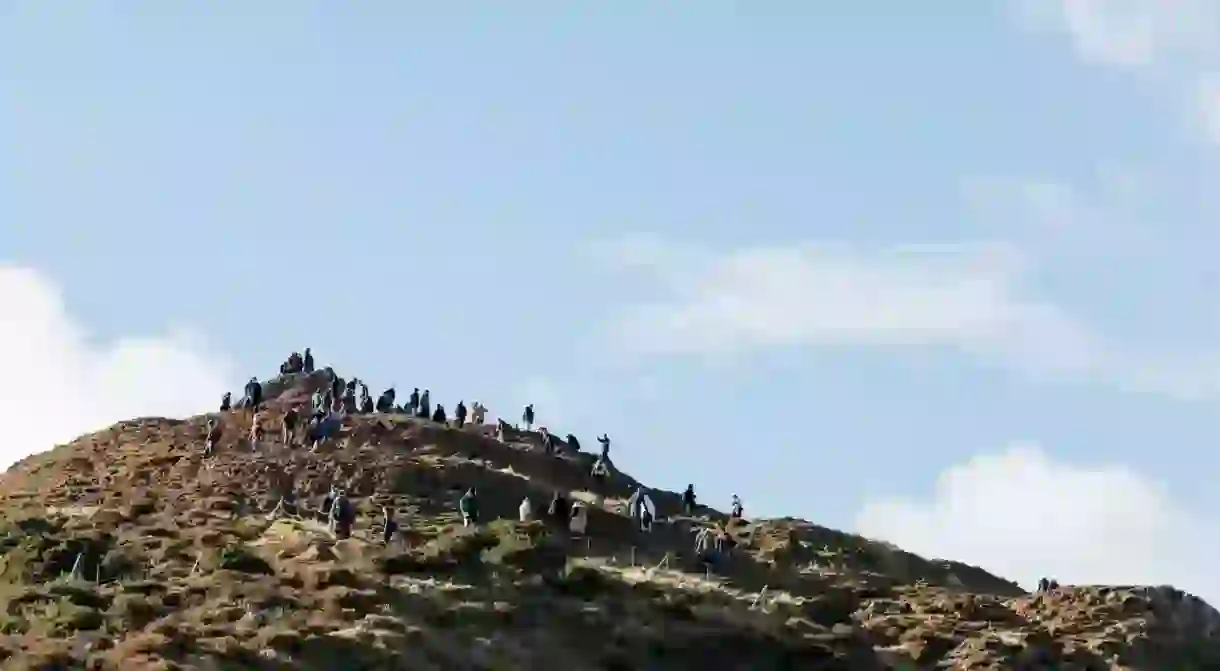Arthur's Seat, Edinburgh's Historic Mountain Peak

Arthur’s Seat, Edinburgh’s dignified mountain cloaked in magnificent amounts of beauty — towers over its city casting alluring shadows and holding secrets of the past. This hill has withstood the tests of time and Mother Nature herself. At a hefty height of 822 feet, Arthur’s Seat is thought to be around 350 million years old. It was conceived by an extinct volcano system of the Carboniferous age and a determined glacier moving from west to east exposing jagged crags of character.

There’s no denying that Arthur’s Seat is entwined with numerous mythological narratives. For instance, since the 15th century, debates surrounding the whereabouts of the real Camelot — the iconic court and castle of Romani-British warrior chief King Arthur— have been an ongoing discourse. Many are with the viewpoint that this mountain is a worthy contender for being one of the potential locations. Additionally, claims state that the name of this impressive rock comes from the legends that pertain to King Arthur, such as the reference in Y Gododdin, the captivating medieval Welsh poem entailing an assortment of elegies to the men of the Brittonic kingdom of Gododdin. Whether or not this is the case, we may never know.

Situated at the spur of this great Scottish hill sits Salisbury Crags, a conglomeration of 151 foot cliffs. These impressive faces have long been a popular spot for avid climbers and vary in difficulty due to the multiple routes up the peak. However, Arthur’s Seat and the Salisbury Crags are not just a pretty sight — these natural wonders actually played an imperative role in the formation of modern geology. The legendary James Hutton himself, or the ‘Father of Modern Geology’, drew upon these areas as a means to form his revolutionary theories that helped put geology on the map as a legitimate science. Hutton honed in on the deposition of the sedimentary and formation of the igneous rocks and deduced that they appeared at different ages in different ways. Today, there is a section containing dolerite sills in the Salisbury Crags named after him.

The summit bears more than the best panoramic views in the city. At Crow Hill and the peak, tracings of a prehistoric hill fort lurk amidst the romantic land. This refuge once existed in full force as a defended settlement. Additionally, hill fort defenses are apparent around the primary massif of Arthur’s Seat above Samson’s Ribs. It’s thought that these forts were the hubs of the Votadini, the peoples of the poem Y Gododdin. X marks the spot on two stony banks that were once an Iron Age hill fort too.

1836 saw a rather unusual and dark unearthing at Arthur’s Seat. While on an epic hunt for rabbits, five boys discovered 17 miniscule coffins within the confines of a cave on the crags. Each of these curious caskets contained a tiny wooden figure. These grim findings remain shrouded in ambiguity, with the reasons as to their purpose being a mystery. Some see these coffins as an act of witchcraft, while others firmly believe that they’re linked to the gruesome Burke and Hare murders.

Like many other ancient sites in Scotland, Arthur’s Seat is riddled with mythology. Legend has it that the Scottish 12th century King David I founded Holyrood Abbey on the spot following a moment of divine intervention at the foot of Arthur’s Seat. After falling off his trusty steed and prior to imminent death by a stag, the king saw a cross amidst the creature’s antlers. The stag then turned and let him go. Today, the Canongate Burgh arms show this divine scene.
When the long winter days and crisp cool weather start to come to a close, visit Arthur’s Seat at the hill facing Holyrood. Traditionally, this is where young girls in Edinburgh would bathe their faces in the dew — as a means to acquire more beauty— on May Day. Robert Fergusson’s 1773 poem ‘Auld Reekie’ tells it well:
On May-day, in a fairy ring,
We’ve seen them round St Anthon’s spring,
Frae grass the cauler dew draps wring
To weet their een,
And water clear as crystal spring
To synd them clean














